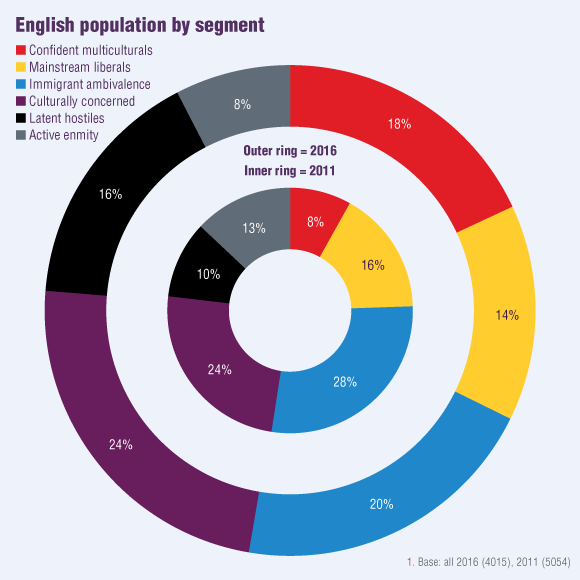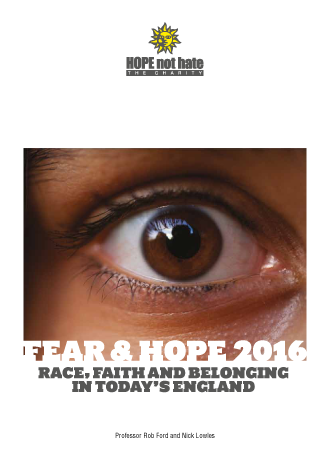The tribes
The English can be broken down into six ‘identity’ tribes. Two are positive towards immigration and a multicultural society, two are strongly opposed. The remaining two are in the middle, one predominately working class and expressing economic anxieties around immigration, the other more affluent but expressing cultural concerns about integration and assimilation.
As this graph shows, there has been significant change in the size of each tribe since 2011.

1. Liberal/multicultural (32% in 2016, 24% in 2011)
a. Confident Multiculturals (18% of the population in 2016, 8% in 2011)
Most likely to be graduates or post graduates, these people are predominantly professionals and managers. They are more prevalent in London and the South East and among people who identify with Labour, Liberal Democrat and the Greens. Outgoing, social and happy with their lives, they are confident about their own, as well as their country’s future, and think Britain has benefitted from immigration. This group has more than doubled in size since 2011, as economic recovery and a growing sense of confidence and security have encouraged more people to adopt an optimistic, outward looking perspective.
b. Mainstream Liberals (14% in 2016, 16% in 2011)
These people are optimistic, self-motivated and for the most part educated to at least degree level. They see immigration as a net benefit to the country, and usually differ from Confident Multiculturals only in their level of enthusiasm. This group has remained roughly the same size as in 2011.2. Concerned/ambivalent (44% in 2016, 52% in 2011)
a. Immigration Ambivalents (20% in 2016, 28% in 2011)
These people are less financially secure and less optimistic about the future. They are more likely to be working class, to live in social housing and to view immigration through the prism of its economic impact on their opportunities and the social impact on their communities. Muslims and other BME (Black Minority Ethnic) groups are more prevalent here as are the largest single segment of those who identify with Labour. This group has declined sharply in size since 2011 – given immigration ambivalents’ greater sensitivity to economic conditions, this is most likely due to the improvement in national economic conditions and in household economic optimism over the past five years.
b. Culturally Concerned (24% in 2016, 24% in 2011)
Generally older and more prosperous than other groups, many are (or have been) professionals and managers. They are more likely to view immigration as a cultural issue with concerns about the impact of immigration on national identity and about immigrants’ willingness to integrate. This group is the same size now as in 2011 (or roughly a quarter of English respondents). It forms the largest segment of those identifying with the Conservative Party, though it is much less dominant within the party in 2016 than it was in 2011.
3. Anxious/hostile (24% in 2016, 23% in 2011)
a. Latent Hostiles (16% in 2016, 10% in 2011)
More likely to be older, not university-educated, and more than likely working class. They view their own future with uncertainty and Britain’s future with pessimism. For them, immigration has undermined British culture, public services and their own economic prospects. They would support political forces that stood-up for their identity and way of life, but are less confrontational than those in Active Enmity. This group has grown considerably since 2011, but the most likely explanation is re-engagement with the political process from people formerly in the active enmity segment, which has declined sharply. The latent hostiles form the largest segment of those identifying with UKIP, and the rise of UKIP to political prominence may explain the greater political engagement of hostile identity segments in 2016 compared to 2011.
b. Active Enmity (8% in 2016, 13% in 2011)
Drawing more support from the unskilled and the unemployed, these people are the most deeply disengaged from traditional political processes and the most hostile to immigrants and what they think immigration represents. Opposed to all ethnicities or religions other than their own, many also believe that violence is acceptable if it is a consequence of standing up for what is ‘right’. This group has declined sharply since 2011, an encouraging development which suggests that even those with deep concerns about immigration and identity are now more willing to engage with the political system, and less willing to consider direct action or violence as a means to express their concerns.
